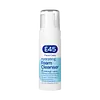What's inside
What's inside
 Key Ingredients
Key Ingredients

 Benefits
Benefits

 Concerns
Concerns

 Ingredients Side-by-side
Ingredients Side-by-side

Water
Skin ConditioningCocamidopropyl Betaine
CleansingLaureth-7 Citrate
CleansingSodium Methyl Cocoyl Taurate
CleansingSodium Cocoamphoacetate
CleansingPhenoxyethanol
PreservativeDecyl Glucoside
CleansingDicaprylyl Ether
EmollientSodium Chloride
MaskingGlyceryl Oleate
EmollientCitric Acid
BufferingDisodium EDTA
Betaine
HumectantSodium Hydroxide
BufferingXylitol
HumectantEthylhexylglycerin
Skin ConditioningCoconut Acid
CleansingGlycerin
HumectantPropylene Glycol
HumectantBenzoic Acid
MaskingHelichrysum Italicum Extract
AntiseborrhoeicTocopherol
AntioxidantHydrogenated Palm Glycerides Citrate
EmollientMagnesium Chloride
Manganese Chloride
Skin ConditioningFerric Chloride
AstringentCalcium Chloride
AstringentCupric Chloride
Skin ConditioningZinc Chloride
AntimicrobialWater, Cocamidopropyl Betaine, Laureth-7 Citrate, Sodium Methyl Cocoyl Taurate, Sodium Cocoamphoacetate, Phenoxyethanol, Decyl Glucoside, Dicaprylyl Ether, Sodium Chloride, Glyceryl Oleate, Citric Acid, Disodium EDTA, Betaine, Sodium Hydroxide, Xylitol, Ethylhexylglycerin, Coconut Acid, Glycerin, Propylene Glycol, Benzoic Acid, Helichrysum Italicum Extract, Tocopherol, Hydrogenated Palm Glycerides Citrate, Magnesium Chloride, Manganese Chloride, Ferric Chloride, Calcium Chloride, Cupric Chloride, Zinc Chloride
Water
Skin ConditioningCaprylic/Capric Triglyceride
MaskingCetearyl Alcohol
EmollientPolyglyceryl-3 Rice Branate
EmulsifyingPropanediol
SolventCoco-Caprylate/Caprate
EmollientButyrospermum Parkii Butter
Skin ConditioningPrunus Amygdalus Dulcis Oil
Skin ConditioningBenzyl Alcohol
PerfumingCetearyl Glucoside
EmulsifyingPolyglyceryl-10 Eicosanedioate/Tetradecanedioate
Skin ConditioningBetaine
HumectantAmmonium Acryloyldimethyltaurate/Vp Copolymer
Simmondsia Chinensis Seed Oil
EmollientGlycerin
HumectantDecyl Glucoside
CleansingTocopheryl Acetate
AntioxidantDehydroacetic Acid
PreservativeSodium Hyaluronate
HumectantTrisodium Ethylenediamine Disuccinate
Polyglutamic Acid
Skin Conditioning1,2-Hexanediol
Skin ConditioningCaprylyl Glycol
EmollientWater, Caprylic/Capric Triglyceride, Cetearyl Alcohol, Polyglyceryl-3 Rice Branate, Propanediol, Coco-Caprylate/Caprate, Butyrospermum Parkii Butter, Prunus Amygdalus Dulcis Oil, Benzyl Alcohol, Cetearyl Glucoside, Polyglyceryl-10 Eicosanedioate/Tetradecanedioate, Betaine, Ammonium Acryloyldimethyltaurate/Vp Copolymer, Simmondsia Chinensis Seed Oil, Glycerin, Decyl Glucoside, Tocopheryl Acetate, Dehydroacetic Acid, Sodium Hyaluronate, Trisodium Ethylenediamine Disuccinate, Polyglutamic Acid, 1,2-Hexanediol, Caprylyl Glycol
Ingredients Explained
These ingredients are found in both products.
Ingredients higher up in an ingredient list are typically present in a larger amount.
Betaine is a common humectant (a substance that promotes retention of moisture). It's known to be gentle on the skin and can help balance hydration.
This ingredient is best for improving hydration and soothing irritated skin. Studies also show it helps even out skin tone.
Fun fact: Betaine is naturally created in the skin and body. The kind found within cosmetic products can be either plant-derived or synthetic.
Another name for betaine is trimethylglycine.
Learn more about BetaineDecyl Glucoside is a glucose-based surfactant and emulsion stabilizer. It is created by reacting glucose with the fatty acids from plants.
Surfactants help clean the skin by trapping oil, sebum, and dirt to be washed away. As an emulsion stabilizer, it stabilizes the ingredients in a product by preventing them from separating.
This ingredient is biodegradable and non-toxic. This ingredient is commonly found in baby shampoos.
Decyl Glucoside is sometimes used to stabilize the UV filter Tinosorb.
Learn more about Decyl GlucosideGlycerin is already naturally found in your skin. It helps moisturize and protect your skin.
A study from 2016 found glycerin to be more effective as a humectant than AHAs and hyaluronic acid.
As a humectant, it helps the skin stay hydrated by pulling moisture to your skin. The low molecular weight of glycerin allows it to pull moisture into the deeper layers of your skin.
Hydrated skin improves your skin barrier; Your skin barrier helps protect against irritants and bacteria.
Glycerin has also been found to have antimicrobial and antiviral properties. Due to these properties, glycerin is often used in wound and burn treatments.
In cosmetics, glycerin is usually derived from plants such as soybean or palm. However, it can also be sourced from animals, such as tallow or animal fat.
This ingredient is organic, colorless, odorless, and non-toxic.
Glycerin is the name for this ingredient in American English. British English uses Glycerol/Glycerine.
Learn more about GlycerinWater. It's the most common cosmetic ingredient of all. You'll usually see it at the top of ingredient lists, meaning that it makes up the largest part of the product.
So why is it so popular? Water most often acts as a solvent - this means that it helps dissolve other ingredients into the formulation.
You'll also recognize water as that liquid we all need to stay alive. If you see this, drink a glass of water. Stay hydrated!
Learn more about Water